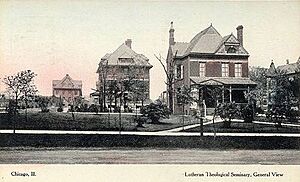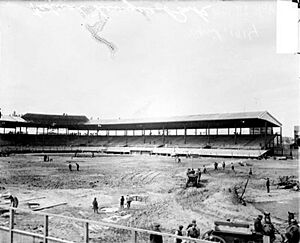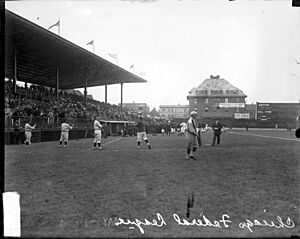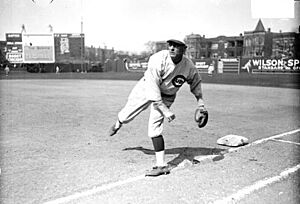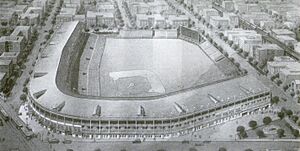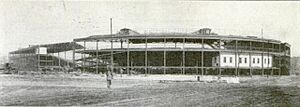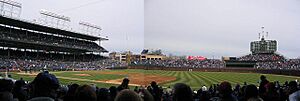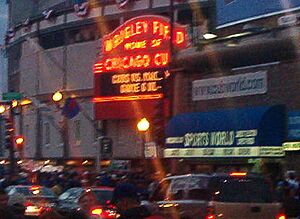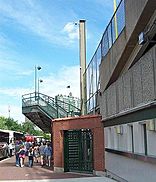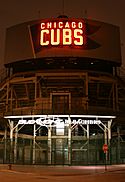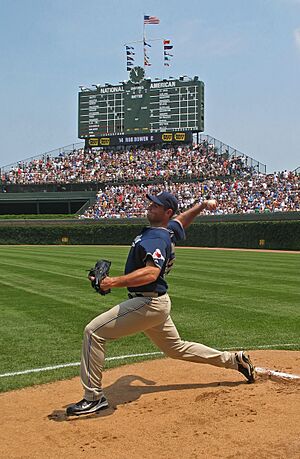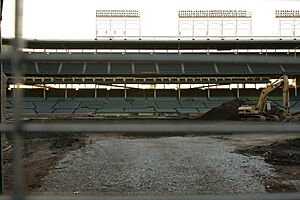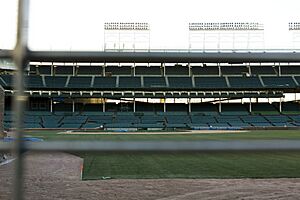History of Wrigley Field facts for kids
The history of Wrigley Field, the famous home of the Chicago Cubs baseball team, started long before the Cubs ever played there. It's a place full of exciting stories and changes!
Contents
Before the Big Leagues Came (Early 1900s)
At the start of the 1900s, the land where Wrigley Field now stands was home to the Chicago Lutheran Theological Seminary. Imagine a quiet school campus instead of a roaring baseball stadium! This land had been owned by a missionary named William Passavant for many years.
The seminary started small, with classes in a little chapel. Soon, more buildings were added, like the president's house and Eliza Hall, which held the library and classrooms. The area was peaceful and mostly empty back then.
However, the neighborhood around the seminary began to change quickly. The "L" train system (Chicago's elevated train) expanded into the area in 1900, bringing more people and buildings. As the area became busier, the seminary decided it was too noisy for a school. They wanted to sell their land and find a quieter spot.
Meanwhile, some baseball team owners saw an opportunity. They heard that a minor league called the American Association wanted to expand into Chicago. Chicago was a great city for baseball, already having the Cubs (National League) and the White Sox (American League).
Owners like Charles Havenor and the Cantillon brothers looked for the best open land on the North Side of Chicago. The seminary's location was perfect! In 1909, the seminary sold the property to them for $175,000 and moved to a suburb. The new owners planned to build a baseball park, but their plans faced some delays. For a few years, the old seminary buildings were even used as homes.
Weeghman Park and the Federal League (1913–1915)
In 1913, a new baseball league called the Federal League started. It began as a minor league, but its leaders soon wanted it to become a major league, just like the National and American Leagues.
A wealthy Chicago businessman named James A. Gilmore took over the Federal League. He brought in two partners for the Chicago team: William Walker and the lively Charles A. Weeghman. Weeghman, known as "Lucky Charlie," had made his money from lunch counters. He became the main person in charge of the Chicago team.
Weeghman made big news by signing a star player, Joe Tinker, in December 1913. This made the team, called the Chi-Feds, want to build their own big stadium.
Weeghman decided to build the new park on the old seminary grounds. Even though other baseball leagues tried to stop him, Weeghman got a long-term lease for the land in late 1913. He hired Zachary Taylor Davis, who also designed Comiskey Park (home of the White Sox), to create the new stadium.
Construction began on February 23, 1914, just two months before the first game! Workers built the park quickly, and it was ready for opening day on April 23, 1914.
The new stadium was called Weeghman Park. It was built with modern steel and concrete. It had a single-deck grandstand that curved from right field all the way to the left field corner. There was even a small area for the press on the roof behind home plate.
If you visited Weeghman Park back then, the outfield would look very different from today. The distances to the fences were quite short. The right field fence was only about 300 feet from home plate. Left field was also short because some old seminary buildings were still standing there. The left field fence also had a large scoreboard.
After many home runs were hit in the first few games, Weeghman realized the left field wall was too close. He had the fence moved back about 25 feet! To do this, they even had to remove the front porch of an old seminary building.
Before the 1915 season, Weeghman made even more changes. The old seminary buildings in left field were finally torn down. In their place, he built new wooden bleachers, which are seats in the outfield. This increased the park's seating capacity to about 18,000. The scoreboard was also moved to center field, where it has been ever since.
The Chicago team was renamed the Chicago Whales for the 1915 season. Weeghman Park quickly became a favorite place to watch baseball in Chicago. Weeghman was known for keeping the park clean and for being great with fans. He started "Ladies' Day" every Friday and was the first owner to let fans keep foul balls! His food was also top-notch.
Even though the Federal League had exciting games, it was losing a lot of money. In December 1915, the League closed down. But Charles Weeghman was lucky! He was allowed to buy the Cubs team for $500,000. He quickly moved the Cubs from their old, run-down stadium to his modern Weeghman Park for the 1916 season.
From Weeghman Park to Cubs Park to Wrigley Field (1916–1932)
The Cubs played their first game at Weeghman Park on April 20, 1916. They won 7-6 against the Cincinnati Reds. In 1918, the Cubs won the National League championship. However, because of World War I, the baseball season ended early. The Cubs also struggled financially, so they had to play their World Series games at the larger Comiskey Park. They lost the series to Babe Ruth and the Boston Red Sox. This loss might have been the final reason Charlie Weeghman left baseball.
Even though Weeghman was the main owner in 1916, other investors had bought small parts of the team. One of these investors was William Wrigley, who made his fortune from chewing gum. As Weeghman's money problems grew, Wrigley bought more and more shares of the team. By November 1918, Weeghman sold his remaining shares to Wrigley and left baseball for good. Wrigley gained full control of the Cubs by 1921.
After Weeghman left, the park was generally called Cubs Park starting in 1919. Even though the Cubs had star players like Grover Alexander and Gabby Hartnett, the team didn't win many championships in the early 1920s.
Despite the team's struggles, fans still loved Cubs Park. In 1922, over 542,000 fans came to watch the games, which was the second-highest attendance in the National League!
Big Changes to Cubs Park (1922–1923)
By 1922, William Wrigley decided that Cubs Park needed a major upgrade. He wanted to expand both the seating and the playing field. Instead of tearing down the grandstand, Wrigley hired the original architect, Zachary Taylor Davis, to expand around the existing structure.
The grandstand was cut into three parts. The section behind home plate was moved about 60 feet west. The left field section was moved about 100 feet northwest. The empty spaces were then filled with more seats, making the grandstand much longer. This created the unique "dog leg" shape you can still see today on the first base side.
These changes made right field much bigger. New bleachers were also added in right field. The old wooden bleachers in left field were replaced with new steel-framed seats. These renovations increased the park's capacity from about 18,000 to 31,000 seats! The field dimensions also changed, making it about 320 feet to left field, 318 feet to right, and 446 feet to straightaway center.
Work on these big changes started in December 1922 and was finished in time for the 1923 season. Many people called it the "new" Cubs Park. Fans flocked to the park, and attendance jumped to over 700,000 in 1923. However, the Cubs team still didn't win much.
The new left field bleachers were so close that right-handed hitters found it too easy to hit home runs. So, in 1925, half of the left field bleachers closest to the foul line were removed. This left a smaller section of seats and made the left field line a much longer 364 feet from home plate, which reduced the number of home runs.
Adding a Second Deck (1927–1928)
By 1926, the Cubs were very popular, with nearly 900,000 fans visiting the park. After the season, work began to add a second deck to the grandstand. The goal was to finish it by the start of the 1927 season, but only the third-base side was completed in time, making the park look a bit uneven.
Before the 1927 season began, Cubs Park was officially renamed Wrigley Field.
Even with the upper deck only half-finished, the Cubs drew over 1.1 million fans in 1927, becoming the first National League team to do so! The Cubs also became a much better team under manager Joe McCarthy.
The upper deck was finally completed for the 1928 season. In 1929, the Cubs had one of the best lineups in baseball history, with stars like Hack Wilson and Rogers Hornsby. They easily won the National League championship. Season attendance soared to nearly 1.5 million fans, a record that lasted for 17 years!
For the 1929 World Series, Wrigley even added temporary wooden bleachers on Waveland and Sheffield Avenues, increasing the park's capacity to about 50,000. These streets were closed to traffic. However, the Cubs lost the series in five games.
By the early 1930s, the outfield distances were set: 364 feet to the left field line, 321 feet to the right field line, and 440 feet to the deepest part of center field.
Over the years, the concrete in the upper deck was replaced because of wear and tear from Chicago winters. In 2004, some pieces of concrete fell, leading to more safety checks.
"Beautiful Wrigley Field" (1932–1981)
Building the Famous Bleachers (1937)
Wrigley Field is famous for its Boston ivy growing on the outfield walls. This ivy was planted in 1937 by Bill Veeck, whose father used to be the team president. If a ball is hit into the ivy and lost, it's called a ground rule double. This means the runner gets to go to second base.
Wrigley Field is also known for its manual scoreboard, which Bill Veeck also put up. No batted ball has ever hit the scoreboard!
In 1937, the Cubs planned to rebuild the bleachers with concrete instead of wood. These new bleachers would have brick fronts, which would soon be covered in ivy. The plans also called for extending the left field bleachers to make the outfield look more balanced. The curved parts between the bleachers became known as the "wells."
Construction happened during the summer, and the new bleachers were ready by September 4. Bill Veeck's famous ivy was planted soon after, but it took about a year to fully grow. He planted fast-growing Bittersweet and the more famous Boston ivy.
Another idea was to plant Chinese elm trees on the steps leading up to the scoreboard, but the strong winds kept blowing the leaves off. The trees are long gone now.
One problem with the new bleachers was in straightaway center field. On sunny days, batters had trouble seeing the ball against the white shirts of the fans sitting there. Various solutions were tried, including a screen and a green tarp, but none worked perfectly.
After the 2005 season, the plants in center field were temporarily removed for reconstruction. A lounge was built in the upper part of this area, and new juniper bushes were placed in the lower part.
In 1970, a "basket" (a chain-link fence) was installed along the top of the outfield wall. This was to stop fans from interfering with fly balls and to improve safety. The basket angles away from the wall and is higher, which helps pitchers.
First Try at Lights (1941)
Lights were supposed to be added to Wrigley Field in 1942. But after the attack on Pearl Harbor, the owner, Philip K. Wrigley (William Wrigley's son), gave the materials needed for the lights to the war effort instead.
However, Wrigley Field did host its first night game on July 1, 1943! It was an exhibition game for the All-American Girls Professional Baseball League (AAGPBL) as part of a Women's Army Corps recruiting event. Temporary lights were set up for this special occasion. The AAGPBL played another night game at Wrigley the next year.
After the war, baseball was very popular, and P. K. Wrigley decided not to install permanent lights. He believed Wrigley Field should remain a place for day baseball. So, Wrigley Field was the last major league park to get permanent lights, which didn't happen until 1988.
"Building a New Tradition in the Friendly Confines" (1981–Present)
Night Baseball Arrives (1988)
For many years, the Wrigley family ran the Cubs almost like a hobby. But in 1981, the Tribune Company bought the team and saw it as a business. They immediately started talking about installing lights, which caused a big debate. P. K. Wrigley had predicted that lights would upset the neighborhood, and he was right!
Many people who lived near Wrigley Field didn't want lights because of the extra noise and crowds from night games. Many Cubs fans also loved that Wrigley Field was the last park to only play day games. It felt like a special part of baseball history.
The city of Chicago even had a rule against night events at Wrigley Field because it was in a residential neighborhood. The Tribune Company tried to compromise by scheduling many 3:00 PM games, which often ended in the evening but didn't need lights.
The debate became more intense in the early 1980s when the Cubs started playing better. In 1984, the Cubs won their division. The baseball commissioner at the time said the Cubs would lose their home field advantage in the World Series if they made it, because most World Series games were played at night. The Cubs lost in the playoffs that year, so it didn't matter. But the next year, a new commissioner said the Cubs would have to play all future playoff games at another stadium if they didn't have lights.
The Cubs, led by team president Dallas Green, then made a strong statement: either Wrigley Field gets lights, or the Cubs would move out of town! Green even considered having the Cubs play at the White Sox's stadium for a year to show the neighborhood how much they would lose. The Cubs also looked at moving to suburbs like Arlington Heights or Schaumburg. There was even talk of selling Wrigley Field to DePaul University and building a new park in Rosemont.
This changed the debate completely. Even those who strongly opposed lights didn't want the Cubs to leave Chicago. In the fall of 1987, Chicago's mayor, Harold Washington, suggested a compromise: the Cubs could install lights, but they would be limited to a certain number of night games each year. The city approved this in February 1988. Major League Baseball then awarded the Cubs the 1990 All-Star Game.
The first major league night game at Wrigley was supposed to be on August 8, 1988, but it was rained out. The first official night game was played the next night, August 9, against the New York Mets. This ended a streak of 5,687 consecutive home day games! However, it wasn't the first night game ever at Wrigley, as the All-American Girls Professional Baseball League had played night games there with temporary lights in the 1940s.
Since 1989, the Cubs have been limited to 18 night games per season, plus any playoff games that need to be played at night for TV. Because there are so few night games, they are considered a special "event" and almost always sell out quickly.
Wrigley Field has changed a lot over its many years. Very little of the original 1914 structure is still visible. For example, the original outer brick wall of the bleachers was removed during a renovation and later sold to the public!
Bleacher Expansion and Renovation (2005–2006)
After much discussion, the bleachers were expanded by about 1,900 seats after the 2005 season. The outer brick wall, one of the last parts of the 1914 stadium, was removed. Much of the 1937 construction behind the ivy-covered wall was also taken out.
The new bleachers were built over the sidewalks, supported by new brick walls that matched the original style. The sidewalk became a bit narrower. A large luxury suite was built in the upper part of the center field area, and new juniper plants were added below it. A new chain-link fence gate was also added in the right field corner, so people walking by can see into the ballpark.
On March 30, 2006, the Cubs announced the bleachers would be renamed the Bud Light bleachers. New ivy was planted on the rebuilt exterior walls: Boston ivy on the sunny Sheffield wall and English ivy on the shady Waveland wall.
In 2008, the Cubs got permission to add 80 new seats and new signs, bringing Wrigley Field's capacity to 41,198 people.
Giving Wrigley a New Field (2007–2008)
At the end of the 2007 season, two projects began to improve the playing field. A few years earlier, a poll found that players thought Wrigley's field was one of the worst in Major League Baseball. These changes aimed to fix that.
First, the outfield and parts of the infield were replaced with new grass. This was done in just 13 days between the last regular season game and the first playoff game.
Then, a more ambitious project started: installing a modern drainage system. The entire playing surface was removed, and the ground was dug down 14 to 28 inches. A system of 6,000 feet of pipes was buried in special clay to hold 60,000 gallons of water. On top of this, new grass from Colorado was unrolled. This new system, replacing one from 1935, helps the field drain much faster, meaning shorter rain delays!
The infield now sits 14 inches lower than before. This means runners don't have to run slightly downhill when rounding third base, and managers in the dugouts can see the whole outfield. During the digging, workers even found and removed the foundations of old goal posts from when the Chicago Bears football team played at Wrigley Field! They also left a "time capsule" buried under the new turf.
Will it Remain Wrigley Field? (2007–2008)
In 2007, the owner of the Tribune Company, Sam Zell, said he might sell the naming rights for Wrigley Field to help pay off the company's debt. This meant the stadium's name could change! Many Chicago baseball fans felt that the park was too historic to have its name changed.
However, the famous Wrigley Field Marquee (the big sign outside) is protected by the Chicago city council and is a local landmark. So, even if the stadium's name changed, the marquee would stay the same.
Sale of the Cubs (2009)
In 2009, the Tribune Company sold the Cubs (and Wrigley Field) to Thomas S. Ricketts. Ricketts said, "We don't have any naming-rights discussions going on at all. I think Wrigley is the name we are going to go with." This was great news for fans who wanted the name to stay the same!
Ricketts also planned more improvements, including a new "triangle building" next to the park. This building would house team offices, a store, and a weight room for players.
New Video Screens and Bleacher Work (2014–2017)
In October 2014, a big 3-year renovation project began under the Ricketts family. This included expanding the bleachers and adding two large Daktronics video screens in left and right field. Five new outfield signs were also planned. The work was slowed by winter weather but continued into the 2015 season.
The city of Chicago closed Seminary Street next to the ballpark, allowing crews to build a 30,000-square-foot underground clubhouse for the team. Above the clubhouse, the Cubs created an outdoor space called "The Park at Wrigley." This area is open to everyone, with or without a ticket, and has seating, grassy areas, and food stands. In winter, it even has an ice rink! The groundskeeper's house, which was once the stadium groundskeeper's home, was also restored in 2016.
Other major changes were completed for the 2017 season. These included a new gate on the west side of the park and moving the bullpens (where pitchers warm up) from along the foul lines to underneath the bleachers. This created more seating in the areas where the bullpens used to be. A complete renovation of the visitor's locker room was planned for 2018–19.
The new video screens were a bit controversial. Some fans didn't like them because they felt it went against Wrigley's traditions. Owners of rooftop clubs across from Wrigley Field, who have a contract to pay the Cubs a percentage of their earnings, also opposed the screens. They said the new signs would block their view of the ballpark and break their contract. However, many of these rooftop properties were eventually sold to the Ricketts family, which helped the bleacher project move forward.



